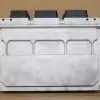Restore Peak Performance to Your Vehicle
Is your vehicle suffering from erratic behavior, a persistent check engine light, or a frustrating no-start condition? These are common indicators of a failing Engine Control Module (ECM), the central computer responsible for managing your engine’s performance, fuel efficiency, and emissions. This direct-fit replacement ECM, part number 12590032, is the definitive solution to restore your vehicle’s factory operation and get you back on the road with confidence. As a critical component, a functioning XLR Engine Control Module is essential for the complex communication between your vehicle’s sensors and mechanical systems.
From the Diagnostic Bay
We had a 2007 Cadillac DTS come into the shop with a complaint of intermittent stalling at stoplights and a check engine light with code P0606 (ECM Processor Fault). The customer had already replaced the spark plugs and an ignition coil with no success. After verifying the battery, alternator, and all major ground connections were solid, we focused on the ECM. Instead of sending the customer to an expensive dealership for a new module and programming, we sourced this exact, pre-programmed unit. Once we provided the vehicle’s VIN, the module arrived ready to install. The swap took less than 30 minutes, and the car started instantly with no codes. The customer was thrilled to have their luxury sedan running smoothly again without the dealership hassle or cost.
Symptoms of a Failing ECM
- ✔ Persistent Check Engine Light (CEL) illumination
- ✔ Engine stalling, sputtering, or misfiring
- ✔ Noticeable decrease in fuel economy
- ✔ Harsh or incorrect automatic transmission shifting
- ✔ Complete no-start condition where the engine cranks but won’t fire
- ✔ Loss of communication with diagnostic scan tools
- ✔ Unexplained performance issues or hesitation
Why Choose Our Pre-Programmed XLR Engine Control Module?
This isn’t just a replacement part; it’s a complete, ready-to-install solution. We take the guesswork and additional cost out of the repair process. When you purchase this module, we use the Vehicle Identification Number (VIN) you provide to flash it with the latest, most stable GM-approved software specifically for your vehicle’s configuration. This ensures perfect compatibility and function right out of the box. There is no need for additional trips to a mechanic or dealer for expensive programming. This unit is a direct replacement for a wide range of GM vehicles and is interchangeable with multiple service numbers, including 12590032, 12602044, 12603530, 12605843, 12607096, 12630457, and 19210737, guaranteeing a precise fit and function for the extensive list of compatible models.
Frequently Asked Questions
Do I need to get this ECM programmed?
No. This Engine Control Module comes fully programmed to your vehicle using the VIN you provide during checkout. This makes the installation process straightforward, often referred to as ‘plug-and-play’, eliminating the need for expensive dealer tools.
Where do I find my vehicle’s VIN?
Your 17-digit VIN can be found on your vehicle’s registration, insurance card, or on the driver’s side of the dashboard visible through the windshield. It is also typically located on the driver’s side door jamb sticker.
Is this compatible with other part numbers?
Yes, this module is a direct replacement for several service numbers, including 12590032, 12602044, 12603530, 12605843, 12607096, 12630457, and 19210737. Please check our detailed fitment list to confirm compatibility with your vehicle.
Will this fix my car’s specific problem?
This ECM will resolve issues directly caused by a faulty engine computer. While the symptoms listed are common for ECM failure, we always recommend a proper diagnosis by a qualified mechanic to confirm the ECM is the root cause of your problem before ordering.
What is a ‘security relearn’ procedure?
In many GM vehicles, a simple ‘security relearn’ or ‘anti-theft relearn’ procedure is required after installation. This process syncs the new ECM with your vehicle’s anti-theft system and can typically be done without any special tools. It usually involves turning the key to the ‘ON’ position for 10-15 minutes, then off, and repeating the cycle two more times.


